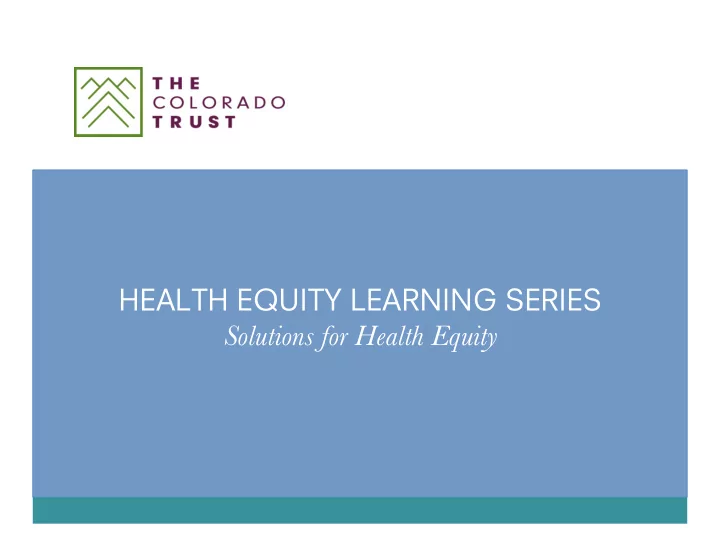

HEALTH EQUITY LEARNING SERIES Solutions for Health Equity
Viewing Parties § Alamosa § Lamar § Colorado Springs § Leadville § Durango § Montrose § Eagle § Monte Vista § Fort Collins § Pueblo § Frisco § Ri fl e § Grand Junction § Steamboat § Gunnison § Telluride § Yuma
#healthequityTCT
Today’s Presenters Anthony Iton, MD Senior Vice President The California Endowment Winston Wong, MD Medical Director Kaiser Permanente
Health is political “ The struggle over the allocation of scarce and precious social goods ”
Argument 1. Where you live influences how long you live 2. Policy/politics shapes neighborhood design & resources- (inner cities, Chinatowns, barrios) 3. Living in a resource deprived community is chronically stressful 4. Chronic stress produces chronic disease 5. Medical care is a necessary but insufficient tool
Policy/Politics Shapes Neighborhoods and resources…..
The FHA and Covenants Ø Federal Housing Administration recommended racially restrictive covenants to receive mortgage guarantees. “ It is necessary that properties shall continue to be occupied by the same social and racial groups ” - Federal Housing Administration Underwriting Manual 1938. l 30 year mortgages, 10% down payment. l Without FHA, 33%-50% down payment. Far shorter mortgages (higher monthly payments).
Exclusionary Policies & Legacy Ø Redlining, racially restrictive covenants Ø School segregation, funding Ø Health insurance Ø Transportation priorities Ø Predatory lending Ø Affordable housing, sub prime lending Ø Immigration Ø Marriage Ø Legacy-Social Security, GI Bill……..
How Does Your “ Neighborhood ” Get Under Your Skin?
Actual Causes of Death ¡ A ¡bridge ¡between ¡genotype ¡and ¡phenotype— ¡a ¡phenomenon ¡that ¡changes ¡the ¡final ¡ outcome ¡of ¡a ¡locus ¡or ¡chromosome ¡without ¡changing ¡the ¡underlying ¡DNA ¡sequence ¡ PERSONAL Biology 20% RESPONSIBILITY!! Lifestyle Epigenetics 51% Smoking Health Care Obesity 10% Nutrtion Alcohol Use ? Environment 19% Source: McGinnis, J.M and Foege, W.H. (1993). “Actual Causes of Death in the United States,” Journal of the American Medical Association.
When the external become mes internal: How we internalize our envi vironme ment Allostatic Load High Demand- Stress Low Control Inadequate Jobs Transportation Stress Long Commutes Lack of Stress access to Housing Stress stores, jobs, services Stress Lack of social Stress capital Crime
Stressed vs. Stressed Out Ø Stressed Ø Stressed Out Increased cardiac output Hypertension & l l cardiovascular diseases Increased available glucose l Glucose intolerance & l insulin resistance Enhanced immune l Infection & inflammation functions l Growth of neurons in l hippocampus & prefrontal Atrophy & death of neurons l cortex in hippocampus & prefrontal cortex
Equal Postsecondary Attendance Rates for Low-Income, High Achievers and High- Income Low Achievers Achievement Low- High- Level (in quartiles) Income Income First (Low) 36% 77% Second 50% 85% Third 63% 90% Fourth (High) 78% 97% Source: NELS: 88, Second (1992) and Third Follow up (1994); in, USDOE, NCES, NCES Condition of Education 1997 p. 64
Family & Culture Health Health Inequities Disparities
Family & Culture Inequities Disparities
Family & Culture Conditions Consequences
Socio-Ecological (society) Medical Model (individuals) Resilient Biased Inclusion Health In Neglected Policies & Beliefs Disease Behavior Death & All Policies & Practices Communities Transformed Sustainability (Isms) Communities Change Policy Building Power Health Clinics Emergency the Advocacy in Place Education Rooms Narrative
Argument 1. Where you live influences how long you live 2. Policy/politics shapes neighborhood design & resources- (inner cities, Chinatowns, barrios) 3. Living in a resource deprived community is chronically stressful 4. Chronic stress produces chronic disease 5. Medical care is a necessary but insufficient tool
Contact Information Tony Iton, MD, JD, MPH Senior Vice President The California Endowment Aiton@calendow.org (510) 271-4310
The Colorado Trust together WE BUILD A BRIGHTER FUTURE November 15, 2013 Winston F. Wong, MD, MS Medical Director, Community Benefit Director, Disparities improvement and Quality Initiatives
Many Factors Shape Health § Health is driven by multiple factors that are intricately linked – of which medical care is one component. Drivers of Health Environmental and Social Factors 20% Medical Personal Care 10% Behaviors 40% Family History and Genetics 30% Source: Determinants of Health and Their Page 29 Contribution to Premature Death, JAMA 1993
We Must Address Health At All Levels Physical and Mental Health Care Clinical Prevention Health Education Research Individual / Access to Social and Economical Family Supports Home / School / Walking Promotion Worksite 1 Community Health Neighborhood / Initiatives Worksite Community Wellness Public Policy Environmental Society Stewardship Public Education Page 30
Total Health Framework Clinical Care and Prevention (20% +) • Access to care • Quality of care • Clinic-community Health Outcomes integration Social & Economic And Wellbeing Factors (40%) • Education • Physiology • Employment Health Behaviors • Income Programs and Policies & Other Individual • Family & social Factors (30%) • Disease and injury support • Community safety • Culture • Diet & activity • Health and function • Tobacco use • Alcohol use Physical • Unsafe sex • Wellbeing Environments (10%) • Genetics • Spirituality • Resilience • Activation • Built environment • Food environment • Media/information environment • Environmental quality Adapted from County Health Page 31 Draft: 9/15/2012 Rankings, 2010 and M. Stiefel, 201 Settings: Home Workplace School Neighborhood Clinic Virtual
Data for clinical and public health Richmond Area § KP members have: § Some higher than average asthma prevalence § Higher hypertension prevalence § Higher obesity prevalence § Higher diabetes prevalence Page 32
Join the discussion… § Q & A from the audience § Submit questions via Twitter: #healthequityTCT
Thank you for joining us!
Recommend
More recommend